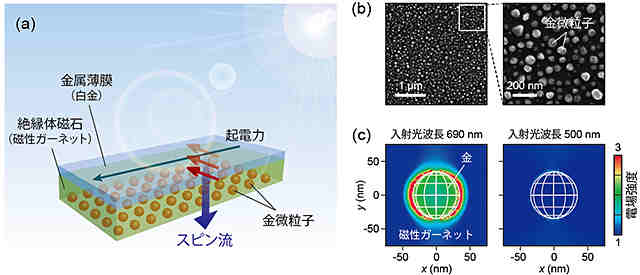
A collaborative research project between Touhoku University and JST reveals the data retention and energy production potential of spintronics via surface plasmon resonance.
Going beyond electronics is a concept that has been well discussed and researched for quite a number of years. The most popular ideas included photonics, and quite recently, spintronics. The field of spintronics in particular, is of special interest in today’s consumer tech, and a new Japanese research may just make the concept even closer to reality.
Researchers at Touhoku University Institute for Materials Research and the Japan Science and Technology Agency (JST) have recently confirmed that surface plasmon resonance can be an important tool in generating spin currents. Surface plasmon resonance, in simple terms, is the reactive vibration of electrons at a point on a surface (which is usually a metal) hit by an incident light. It is a phenomenon that is well used in biosensors and lab-on-a-chip systems, due to the distinct, measurable, and predictable wavelengths the vibrations produce.
In their latest published research paper named “Generation of spin currents by surface plasmon resonance“, the researchers have observed that by directing light onto a magnetic material that contains a special metal particle, a spin current can be produced, and thus controlled. The manipulation and generation of spin currents is the fundamental principle of spintronics, where a spin moment of a single electron particle can be used to store data or transfer energy, in a manner that is similar to quantum computers.
As of this moment, the common methods used to control spin currents are via heat, sound waves, and magnetic fields, with magnetic fields as the current best candidate in the eventual commercialization of the technology. With the introduction of a new element that can control spin currents, the research sees the development of newer, more advanced energy transfer and conversion technologies, which could optimize spintronics technology on an even larger scale.
Read more: JOINT JAPANESE RESEARCH REVEAL NEW BREAKTHROUGH FOR SPINTRONICS
The Latest on: Spintronics
[google_news title=”” keyword=”Spintronics” num_posts=”10″ blurb_length=”0″ show_thumb=”left”]
via Google News
The Latest on: Spintronics
- Revolutionizing Technology: Spintronics Market Surges, Expected to Reach US$ 1.4 Billion by 2033on April 29, 2024 at 5:18 am
Spintronics Market is set to cross worth of US$ 1,394.2 Million at 7.3% CAGR during forecast period 2023 to 2033 | Data analysis by Future Market Insights, Inc.
- A Paradigm Shift in RAM Is About to Make Computing Unstoppableon April 24, 2024 at 5:30 am
Every computer needs Random Access Memory (or RAM) for an operating system’s temporary storage, and there’s many ways to achieve this need for memory speed. One of the leading methods is ...
- Spintronics research shows material's magnetic properties can predict how a spin current changes with temperatureon April 23, 2024 at 10:38 am
Spintronics exploits the intrinsic spin of electrons, and fundamental to the field is controlling the flows of the spin degree of freedom, i.e., spin currents. Scientists are focused on ways to ...
- Spintronics research shows material's magnetic properties can predict how a spin current changes with temperatureon April 22, 2024 at 4:59 pm
Spintronics is a field garnering immense attention for its range of potential advantages for conventional electronics. These include reducing power consumption, high-speed operation, non ...
- Unlocking spin current secrets: a new milestone in spintronicson April 22, 2024 at 4:59 pm
Spintronics is a field garnering immense attention for its range of potential advantages for conventional electronics. These include reducing power consumption, high-speed operation, non ...
- Spintronics: A new path to room temperature swirling spin textureson April 17, 2024 at 10:22 am
Examples of such structures are magnetic bubbles, skyrmions, and magnetic vortices. Spintronics aims to make use of such tiny magnetic structures to store data or perform logic operations with very ...
- Spintronics: A new path to room temperature swirling spin textureson April 16, 2024 at 5:01 pm
Examples of such structures are magnetic bubbles, skyrmions, and magnetic vortices. Spintronics aims to make use of such tiny magnetic structures to store data or perform logic operations with ...
- Spintronics Using Altermagnets and Antiferromagnetson April 8, 2024 at 5:00 pm
The field of spintronics has, so far, focused on magnetic systems with uncompensated order, i.e. ferromagnets and ferrimagnets. Both these systems can be easily studied using conventional ...
- mechanical computeron December 31, 2022 at 4:00 pm
[Steve Mould] shows us a different take – the experimentation kit called Spintronics, which goes the mechanical way, using chains, gears, springs and to simulate the flow of current and the ...
- Spintronics enters the mainstreamon October 5, 2022 at 6:24 am
Now, electronics is on the verge of a revolution as the semiconductor industry’s big players start picking up the low-power spintronics technology — and just in time, as Tetsuo Endoh ...
via Bing News










